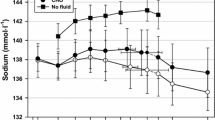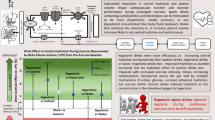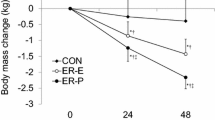Abstract
This study investigated the effects of post-exercise rehydration with fluid alone or with a meal plus fluid. Eight healthy volunteers (five men, three women) were dehydrated by a mean of 2.1 (SEM 0.0)% of body mass by intermittent cycle exercise in a warm [34 (SEM 0)°C], humid [55 (SEM 1)% relative humidity] environment. Over 60 min beginning 30 min after exercise, the subjects ingested a commercially-available sports drink (21 mmol · l−1 Na+, 3.4 mmol · l− K+, 12 mmol · l−1 Cl−1) on trials A and B; on trial C a standard meal [63 kJ · kg−1 body mass (53% CHO, 28%fat,19%protein; 0.118 mmol · kJ−1 Na+, 0.061 mmol · kJ−1 K+)] plus drink (1 mmol · l−1 Na+, 0.4 mmol · l−1 K+, 1 mmol · l−1 Cl−) were consumed. Water intake (in millilitres) was 150% of the mass loss (in grams). The trials took place after an overnight fast and were separated by 7 days. Blood and urine samples were collected at intervals throughout the study. Blood was analysed for haematocrit, haemoglobin concentration, serum osmolality, Na+, Ku+ and Cl− concentrations and plasma angiotensin II concentration. Urine volume, osmolality and electrolyte concentrations were measured. Dehydration resulted in a mean 5.2 (SEM 1.3)% reduction in plasma volume. With the exception of serum osmolality, which was higher on trial B than A at the end of the rehydration period, no differences were recorded for any of the measured parameters between trials A and B. Cumulative urine output following rehydration was lower (P < 0.01) on trial C [median 665 (range 396–1190) ml] than on trial B [median 934 (range 550–1403) ml] which was not different (P = 0.44) from trial A [median 954 (range 474–1501) ml]. Less urine was produced over the 1-h period ending 2 h after rehydration on trial C than on B (P = 0.01). On trials A and B the subjects were in net negative fluid balance by 337 (range 779-minus 306) ml and 373 (range 680-minus 173) ml, respectively (P < 0.01): on trial C the subjects were no different from their initial euhydrated state [median minus 29 (range minus 421−137) ml] 6 h after the end of rehydration (P = 1.00). A larger fraction of total water intake was retained when the standard meal plus drink was consumed. This may have been due to the larger quantities of Na+ and K+ ingested with the meal [mean 63 (SEM 4)mmol Na+, 21.3 (SEM 1.3)mmol K+] than with the drink [mean 42 (SEM 2) mmol Na+, 6.8 (SEM 0.4) mmol K+]. There was no difference between trials B and C in any of the measured blood parameters, but urinary Na+ and K+ excretion were both higher on trial C than B. These results suggest that post-exercise fluid replacement can be achieved by ingestion of water if consumed in sufficient volume together with a meal providing significant amounts of electrolytes.
Similar content being viewed by others
References
Costill DL, Sparks KE (1973) Rapid fluid replacement following thermal dehydration. J Appl Physiol 34:299–303
Dill DB, Costill DL (1974) Calculation of percentage changes in volumes in blood; plasma and red cells in dehydration. J Appl Physiol 37:247–248
Feig PU, McCurdy DK (1977) The hypertonic state. New Eng J Med 297:1444–1454
Gonzalez-Alonso J, Heaps CL, Coyle EF (1992) Rehydration after exercise with common beverages and water. Int J Sports Med 13:399–406
Greenleaf JE (1992) Problem: thirst, drinking behavior, and involuntary dehydration. Med Sci Sports Exerc 24:645–656
Lambert CP, Costill DL, McConnell GK, Benedict MA, Lambert GP, Robergs RA, Fink WJ (1992) Fluid replacement after dehydration: influence of beverage carbonation and carbohydrate content. Int J Sports Med 13:285–292
Lentner C (1981) Geigy scientific tables, 8th edn. Ciba-Geigy, Basle
Maughan RJ (1991) Carbohydrate-electrolyte solutions during prolonged exercise. In: Lamb DR, Williams MH (eds) Perspectives in exercise science and sports medicine, vol. 4: Brown and Benchmark, Carmel, pp 35–85
Maughan RJ, Leiper JB (1995) Effects of sodium content of ingested fluids on postexercise rehydration in man. Eur J Appl Physiol 71:311–319
Maughan RJ, Owen JH, Shirreffs SM, Leiper JB (1994) Post-exercise rehydration in man: effects of electrolyte addition to ingested fluids. Eur J Appl Physiol 69:209–215
Maughan RJ; McArthur M, Shirreffs SM Influence of menstrual status on fluid replacement after exercise-induced dehydration in healthy young women. Br J Sports Med (in press)
Nose H, Mack GW, Shi X, Nadel ER (1988a) Role of osmolality and plasma volume during rehydration in humans. J Appl Physiol 65:325–331
Nose H, Mack GW, ShiX, Nadel ER (1988b) Involvement of sodium retention hormones during rehydration in humans. J Appl Physiol 65:332–336
Paul AA, Southgate DT (1978) McCance and Widdowson's The Composition of Foods, 4th edn. HMSO, London
Verde T, Shephard RJ, Corey P, Moore R (1982) Sweat composition in exercise and in heat. J Appl Physiol 53:1540–1545
Author information
Authors and Affiliations
Rights and permissions
About this article
Cite this article
Maughan, R.J., Leiper, J.B. & Shirreffs, S.M. Restoration of fluid balance after exercise-induced dehydration: effects of food and fluid intake. Europ. J. Appl. Physiol. 73, 317–325 (1996). https://doi.org/10.1007/BF02425493
Accepted:
Issue Date:
DOI: https://doi.org/10.1007/BF02425493




